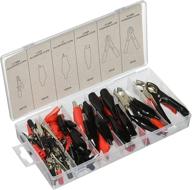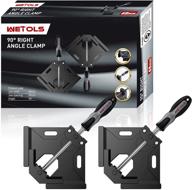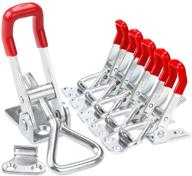How to select the right size MAXPOWER piece for your application?
When selecting a MAXPOWER workholding piece, it is important to consider your specific machining application and requirements. The size of the MAXPOWER piece impacts rigidity, accuracy, and machining envelope. Follow these steps to select the optimal size:
1. Measure the Workpiece
First, measure the dimensions of your raw workpiece or parts. This includes length, width, height and any special geometries. Having the exact workpiece dimensions is crucial for properly sizing the MAXPOWER piece.
2. Consider Machining Envelope
Next, take into account the x, y and z travel required for your machining operations. The MAXPOWER piece must allow clearance for your cutters to access the full work zone. A piece that is too small will limit your machining capabilities.
3. Evaluate Required Rigidity
Consider the forces exerted during your machining process and if the MAXPOWER piece provides adequate rigidity. Larger pieces provide more rigidity. For high force applications like milling, boring and drilling, choose the largest piece that fits your workpiece and machine.
4. Assess Accuracy Needs
If tight tolerances are needed, select a MAXPOWER piece that minimizes deflection and vibration. The larger the piece, the higher the accuracy it can provide.
5. Check Maximum Weight Capacity
Make sure the size MAXPOWER piece you select does not exceed your machine's table weight capacity. This is important for heavy workpieces.
By taking these factors into account, you can determine the optimal MAXPOWER piece size for your particular machining application. The right sized piece provides sufficient rigidity, accuracy and machining access without overhanging or exceeding weight limits. Careful selection optimizes your production results.
How to properly install a MAXPOWER piece in your machine?
To get the best performance from your MAXPOWER workholding piece, proper installation in the machine is crucial. Follow these steps:
1. Clean Mounting Surfaces
- Thoroughly clean table mounting surface
- Clean bottom of MAXPOWER piece
- Remove any oil, grease, dirt or debris
2. Apply Retention Coating
Use recommended adhesive like retaining compound or machine oil on mating surfaces to create maximum holding power.
3. Mount Workholding Piece
- Position MAXPOWER piece in correct location on table
- Align to table T-slots if utilizing clamps
- Set down flat and press firmly to adhere
- Engage clamps/straps and tighten evenly
4. Indicate In
Use a dial indicator to align the MAXPOWER piece precisely square and parallel to machine axes.
5. Apply Workpiece
Clean workpiece mating surface, apply retention coating, set flat in MAXPOWER piece and clamp securely.
6. Verify Rigidity
Perform test cuts and measure part accuracy to confirm adequate rigidity.
Proper preparation, precision mounting, clamping and indicating of the MAXPOWER piece minimizes vibration and deflection. This allows your machine to perform optimally for precision cutting, drilling or milling operations. Care taken during installation directly impacts machining results.
How to maximize rigidity when using a MAXPOWER piece?
Rigidity is crucial for workholding systems to provide precision and accuracy in machining operations. Follow these guidelines when using MAXPOWER pieces to promote maximum rigidity:
Proper Piece Size
- Select MAXPOWER piece as large as possible for the workpiece and machine table.
- Larger pieces help resist cutting forces and minimize deflection.
Secure Mounting
Adhere piece firmly to machine table and utilize multiple tight clamps or straps around the workholding piece perimeter.
Precise Alignment
Indicate the MAXPOWER piece in square and parallel to machine axes. Improper alignment causes instability.
Full Workpiece Support
- Use backing plates, riser blocks or parallels to support workpiece underside if needed.
- Eliminate any workpiece overhang if possible.
Proper Clamping
Clamp workpiece along multiple sides and locations. Clamping force should be evenly distributed.
Minimal Tool Overhang
Keep overhang of cutting tools to a minimum. The farther a tool extends from its holder, the greater its deflection.
Light Machining Cuts
Take light depth of cuts and reduce feed rates. This lowers cutting forces for improved rigidity.
Following these guidelines when utilizing MAXPOWER workholding pieces will maximize system rigidity. This allows for precision machining accuracy even in high force operations like milling and drilling.
How to care for and maintain a MAXPOWER workholding piece?
MAXPOWER workholding pieces are precision machined tools that require proper care and maintenance to keep them performing optimally. Follow these tips:
Cleaning
- Clean pieces after every use to remove machining debris, metal chips, coolant and oils.
- Use a solvent tank or aqueous cleaner to dissolve built-up contaminants.
- Never use abrasives or wire brushes which can damage the piece.
Inspection
Periodically inspect pieces for signs of wear, tear or damage. Look for:
- Nicks, gouges, cracks
- Warping or distortion
- Corrosion
Storage
Store MAXPOWER pieces indoors in a dry, climate controlled space when not in use. Avoid temperature extremes.
Lubrication
Apply a light machine oil to piece surfaces after cleaning to prevent corrosion and enhance release of workpieces.
Reconditioning
Have pieces re-machined periodically to restore flatness and precision tolerances if wear is detected.
Replacements
Replace pieces that are excessively worn or damaged beyond repair. Never attempt to utilize pieces with compromised integrity.
With regular inspection, cleaning, lubrication and care, MAXPOWER workholding pieces will provide years of reliable performance. Proper maintenance saves time and money compared to premature replacement.
How to get the longest life out of your MAXPOWER workholding system?
MAXPOWER workholding is an investment in precision machining performance and productivity. Properly caring for your MAXPOWER pieces, baseplates, tables and accessories can extend their working life significantly. Here are tips for maximizing longevity:
Proper Cleaning
- Clean all workholding components after every use
- Remove machining debris, metal chips, oils, greases etc.
- Use correct solvents/aqueous cleaners compatible with materials
- Dry thoroughly to prevent corrosion
Careful Handling
Avoid dropping, banging or harshly impacting workholding pieces. This can cause microscopic damage over time.
Precision Installation
Indicating in pieces square and parallel to machine axes prevents instability and wear from vibration.
Balanced Clamping
Distribute clamping forces evenly across workpieces. Uneven clamping induces stresses.
Environment Control
Maintain stable, temperate shop environment. Temperature swings expand/contract pieces.
Regular Inspection
Inspect for signs of wear, distortion, corrosion etc. Address issues early before catastrophic failures occur.
Proper Storage
Keep unused pieces in a controlled environment to avoid moisture, contaminants, rust, pitting.
Preventative Maintenance
Recondition, lap or resurface pieces periodically to restore tolerances before wear exceeds specifications.
With regular care, inspection and maintenance as outlined above, MAXPOWER workholding systems can deliver decades of trouble-free performance while maintaining tight machining tolerances. Protect your investment.
How to maximize accuracy and repeatability with the MAXPOWER workholding system?
The MAXPOWER workholding system is engineered for precision and rigidity to achieve consistent and reliable machining results. However, proper use and care is required to realize the full accuracy potential:
Eliminate Vibration
Vibration during machining is the enemy of accuracy. Ensure MAXPOWER pieces are indicated in precisely parallel and square to machine axes. Use maximum clamping force. Take light cuts and reduce feed rates to lower cutting forces.
Maintain Flatness
Flatness tolerances on MAXPOWER pieces must be maintained. Inspect for wear, lap surfaces periodically. Warped pieces introduce variability.
Control Thermal Effects
Allow workpieces and machine to thermally stabilize before cutting. Temperature swings cause expansion and contraction of components.
Use Proper Tooling
Avoid using dull, chipped, worn or inferior cutting tools. This leads to higher cutting forces, tool deflection and poor surface finishes.
Clean Fixture & Workpiece Mating Surfaces
Debris between fixtured components causes uneven loading. This results in micromovement and dimensional errors.
Follow Clamping Sequence
Always clamp workpieces in same sequence and with same clamping force. Inconsistency introduces variance.
Perform Regular Inspection & Maintenance
Check for damaged, worn or corroded components. Preventative maintenance ensures optimal performance.
When properly implemented, these best practices will enable MAXPOWER workholding to deliver our tightest machining tolerances consistently over time for any application. Precision, productivity and profitability will be maximized.










